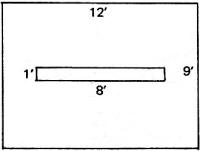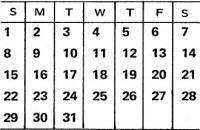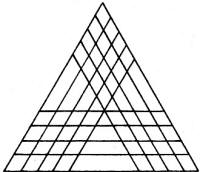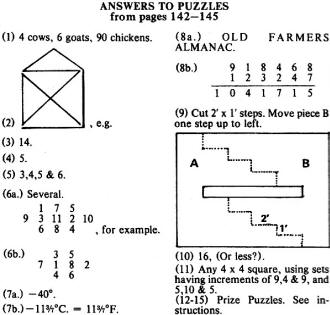Old and New Mathematical Puzzles
|
||
Many of the sets of puzzles and riddles from earlier Old Farmer's Almanacs (OFA) were very different from the ones appearing beginning in the mid 1970s. The newer ones are much more concise in the problem statement and do not require the reader to be privy to what were often esoteric. 1978, the year of this "Old and New Mathematical Puzzles" collection, will be comfortably approachable even by today's standards. In the early 2000s, OFA began publishing more numbnutty puzzles that were very sophomoric. Then for a couple years they published none at all. That's about the time I stopped my multi-decade practice of buying the OFA every year. I probably haven't bought one in 15 years. Sad, but true. Although not a farmer, I always enjoyed reading the monthly astronomical (not astrological) data on sunrise/sunset, moon phases, etc., weather forecasts, historical events on the calendar pages, and there was often interesting articles on a wide variety of topics. The last time I thumbed through an OFA while standing in line at Walmart, it was filled airhead social behavior and multicultural claptrap. Robert Thomas would probably roll over in his grave (to use a trite saying) if he knew what has happened to his fine almanac. Old and New Mathematical PuzzlesBlanton C. Wiggin, Editor In Ecclesiastes, it's said that "There is no new thing under the sun," A German proverb says "There's nothing new but what has been forgotten," This applies to puzzles generally. As you can guess, many old puzzles are wrapped in new clothing and appear original. Most are just adaptations. We start with a few of these. However, for 1978, readers have submitted several unusual puzzles that may be virtually original! The 15 puzzles are graded for difficulty, so that there should be something of interest for everyone. We hope you find them challenging. No calculus, higher math or tricks. We try to include specialized knowledge, if needed, in the puzzle statement. We will award one prize of $15.00 for the best set of solutions to puzzles 12 through 15 received before March 1, 1978. The answers to these four are omitted here. After April 1 , however, we will send the answers to these four, together with a discussion of the other answers, to anyone sending 25¢ and a self-addressed stamped envelope to "Puzzle Answers", Yankee, Inc., Dublin, N.H. 03444. Our usual $5.00 offer holds for any original puzzles we use in the 1979 Old Farmer's Almanac. Closing date for submission is March 1, 1978. Entries become the property of Yankee, Inc. and cannot be acknowledged or returned. Editor will choose among duplicates. For last year's prize set, numbers 12-15, we used a point system to judge as objectively as possible. A basic, unadorned, correct answer is 20 points. For a thorough analysis, an elegant or novel answer, up to 5 points extra. Numerical errors lose only 2 or 3 points, if the method is understood. For 1977, we had a new winner, William J. Butler, Jr., Warwick, R.I., with 89 points. Just behind Butler is perennial entrant and last year's winner, Richard L. Collier, Guilderland, N.Y. with 88. Tied for third, at 86, were Robert C. Lodge, Seattle, and Lynden T. Osgood, Grand Marais, Minnesota. Spencer Schuldt, Bloomington, Minn. had an 82. In some cases the best answer to a particular problem was submitted by others, but these entrants had the most consistently good or bonus answers. Congratulations to all! It is fun to see such good work. 1. Down On The Farm (Difficulty: 1) Farmer Bauer gives his son $100.00 and sends him to the market to buy some animals. Cows are $10.00, goats $2.50, and chickens are fifty cents each. How many from each group does he have to buy to bring home 100 animals by spending exactly $100.00? Mustafa Tayfur, Pittsburgh, Pa.
(Difficulty: 1) Can you continuously trace this complete pattern without running along any line twice? Touching at a point, or crossing is OK. Pat Ginn, Allenstown, N.H. 3. Cat And Mouse (Difficulty: 2) If seven cats can kill seven mice in seven minutes, how many cats would it take to kill 100 mice in 50 minutes? E. H. Luce, Ashtabula, Ohio. 4. Flip Flop (Difficulty: 2) Every Blip is a Blop. Half of all Blops are Blips. Half of all Bleeps are Blops. There are 30 Bleeps and 20 Blips. No Bleep is a Blip. How many Blops are neither Blips nor Bleeps? Leonard Caruso, Rantoul, Illinois. 5. A Right Tetrahedron? (Difficulty: 2) Pythagoras knew that 32 + 42 = 52. Do you know what four consecutive integers have a similar cubic relation, a3 + b3 + c3 = d3? Eugene M. Gettel, Kettering, Ohio. (Difficulty: 3) Using all the digits 1-11, place one digit in each box, so that no two consecutive digits abut each other horizontally, vertically or diagonally. Digit 1 does not repeat after 11. Now try again (right) with the numbers 1-8, same rules. Unsigned. 7. You're Getting Warmer (Difficulty: 3) Many conversions to metric are unnecessary, and most have uneven, irrational conversions, so it is good that the present effort is voluntary, not compulsory. There are a couple of conversions which are fun, however. As you know, 0° C = 32° F, and 100° C = 212° F. Each 1.0° C interval = 1.8° F. a. Where, then, do both scales have the same reading? b. Where do both °F & °C have the same number reading, but opposite signs? G. R. Ray, DeKalb, Illinois. 8. Almanac Arithmetic (right) (Difficulty: 3)
b. The 1978 OFA comes out in the Fall. Using deduction, not your phone dial, what numbers can be substituted for Sidney Kravitz, Dover, New Jersey. (Difficulty: 4) A guest dropped his drink on your 9' x 12' carpet. It stained an 8' x 1' area in the middle. How do you cut out the bad part, cut the remainder into 2 pieces and re-sew it to a solid 10' x 10'? Nancy Broomhead, Kentfield, Cal.
(Difficulty: 4) Dairyman Dan Guernsey has 20 gallons of milk, filling 7- and 13-gallon cans. He also has an empty 19-gallon jug. How many steps, pouring back and forth, must he take to get exactly 10 gallons into each of the larger containers for two customers? Robert A. Stark, Saugerties, N. Y. 11. What A Square! (Difficulty: 4) From which 4 x 4 square of 16 dates, on this January 1978 calendar, can you select 2 sets (not necessarily squares) of 4 dates each, all different, so that the sum of the dates of one set equals the sum of the dates of the other set, and the sums of their squares and the sums of their cubes are also equal? Clifford Dickinson, Camas, Wash. 12. Riding The Rounds (Difficulty: 5) An infantry column 20 miles long does 40 miles per day in forced 10-hour marches. It is 1/2 mile wide. a. A rider starts from the left rear corner of the column, at the beginning of the march, and rides around the column at 10 mph. How far does he ride to complete his circuit? b. Another rider starts at the right rear, delivers messages to the front and returns directly to the rear, exactly twice each march. What is his average speed? William Voshell, Baltimore, Md., and F.C. Richardson, Belmont, Mass. (Difficulty: 5) Hockey league standings are usually based on points: Win = 2; Tie = 1; Loss = 0. In this league, each team plays each other once. Part way through the season, the statistician lost some of the records. Can you reconstruct the league standings, and the scores of all the games played (see table below)? Norman Rowe, Collinsville, Illinois. 14. Ways To Weigh (Difficulty: 5) Several years ago we asked how many ways one could find a single counterfeit coin among 12, and tell if it were heavy or light, with a 2-pan balance (not scale) in 3 weighings. This year we have advanced to 1 bad coin in 120, in 5 weighings. Same questions. Stafford Beach, Wilmington, Ma. (Difficulty: 5) Just as 4 factorial = 4! = 4 x 3 x 2 x 1 = 24, 4 triangular = 4 Δ 4 + 3 + 2 + 1 = 10.9 Δ = 45. Of course, a prime cannot be divided evenly by anything but 1 and itself. a. Are there any triangulars which are prime? If so, some examples, please. If not, why not? b. What 4 prime numbers have triangular values which add up to 1978? c. Now using prime numbers only, fill only the 48 diamond-shaped spaces so that each of the 12 lines, each containing 8 primes, will add up to 1978. Use any prime number only once. Wayne E. Russell, Davenport, Iowa ***
Answers to Puzzles
(2) <image> (3) 14. (4) 5. (5) 3,4,5 & 6. (6a.) Several. <image> (6b.) <image> (7a.) -40° (7b.) -11 3/7°C. = 11 3/7°F. (8a.) Old Farmers Almanac (8b.) <image> (9) Cut 2' x 1' steps. Move piece B one step up to left. (10) 16, (Or less?). (11) Any 4 x 4 square, using sets having increments of 9, 4 & 9, and 5, 10 & 5. (12-15) Prize Puzzles. See instructions.
Posted January 11, 2024 |
||

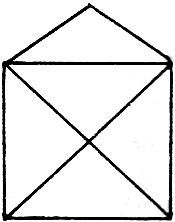 2. Once Over Lightly (right)
2. Once Over Lightly (right)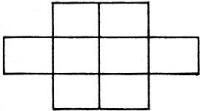

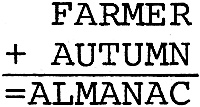 a. In the 1977 OFA, Founder Thomas' 18th-century phone list totalled 653 3276377
2562622. Using your telephone dial, what words could this translate into?
a. In the 1977 OFA, Founder Thomas' 18th-century phone list totalled 653 3276377
2562622. Using your telephone dial, what words could this translate into? 